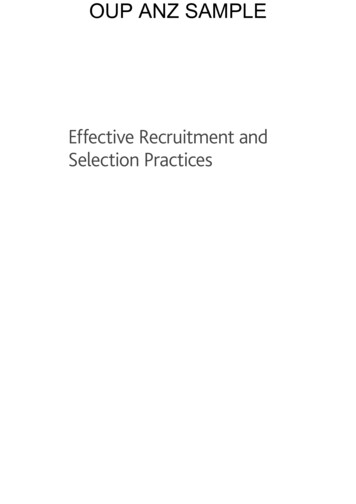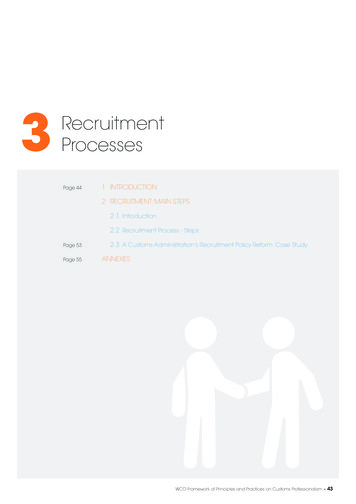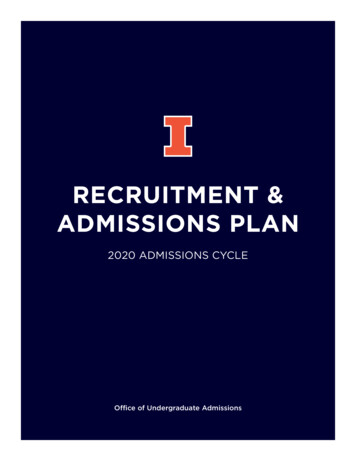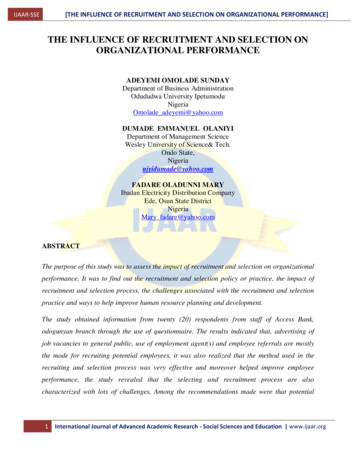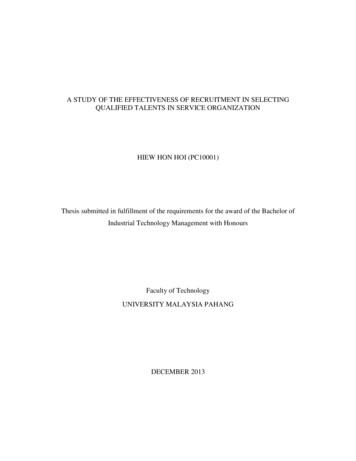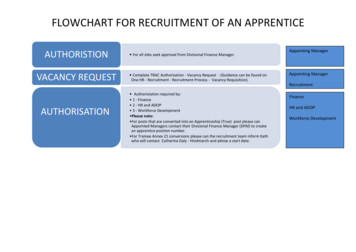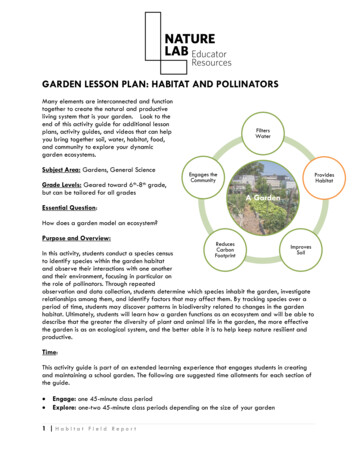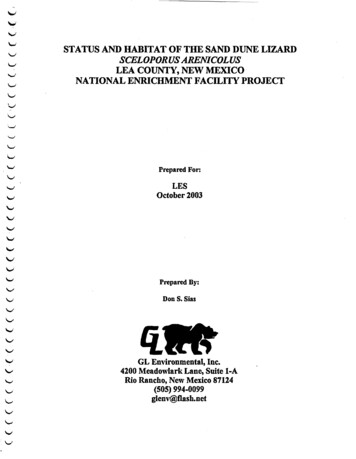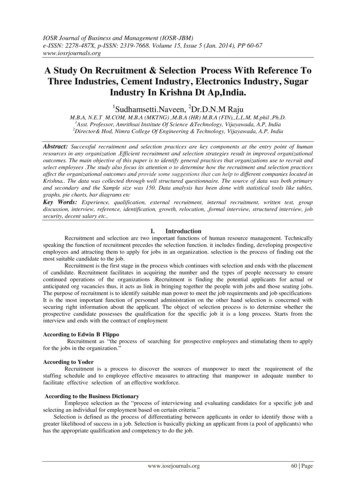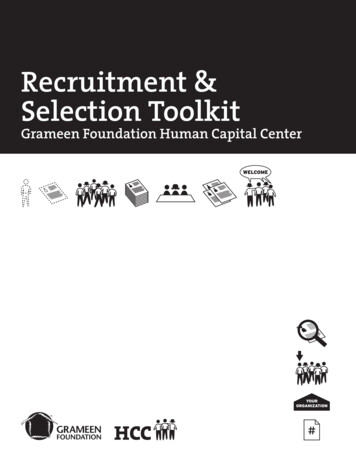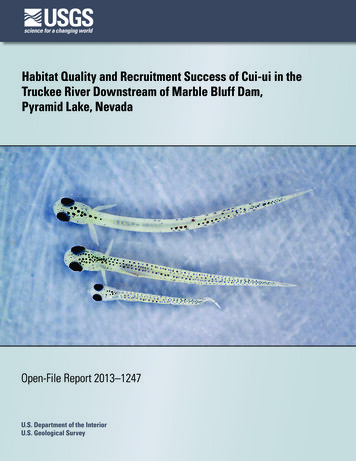
Transcription
Habitat Quality and Recruitment Success of Cui-ui in theTruckee River Downstream of Marble Bluff Dam,Pyramid Lake, NevadaOpen-File Report 2013–1247U.S. Department of the InteriorU.S. Geological Survey
Habitat Quality and Recruitment Success of Cui-ui inthe Truckee River Downstream of Marble Bluff Dam,Pyramid Lake, NevadaBy G. Gary Scoppettone, Peter H. Rissler, J. Antonio Salgado, and Beverly HarryOpen-File Report 2013–1247U.S. Department of the InteriorU.S. Geological Survey
U.S. Department of the InteriorSALLY JEWELL, SecretaryU.S. Geological SurveySuzette M. Kimball, Acting DirectorU.S. Geological Survey, Reston, Virginia: 2013For more information on the USGS—the Federal source for science about the Earth,its natural and living resources, natural hazards, and the environment—visithttp://www.usgs.gov or call 1–888–ASK–USGSFor an overview of USGS information products, including maps, imagery, and publications,visit http://www.usgs.gov/pubprodTo order this and other USGS information products, visit http://store.usgs.govSuggested citation:Scoppettone, G.G., Rissler, P.H., Salgado, J.S., and Harry, Beverly, 2013, Habitat quality andrecruitment success of cui-ui in the Truckee River downstream of Marble Bluff Dam, Pyramid Lake,Nevada: U.S. Geological Survey Open-File Report 2013-1247, 22 p. ,http://pubs.usgs.gov/of/2013/1247/.Any use of trade, product, or firm names is for descriptive purposes only and does not implyendorsement by the U.S. Government.Although this report is in the public domain, permission must be secured from the individualcopyright owners to reproduce any copyrighted material contained within this report.
ContentsAbstract . 1Introduction . 2Study Area and Background . 2Materials and Methods . 4Substrate Downstream of Marble Bluff Dam . 5Results. 6Larvae Recruitment Upstream and Downstream of Marble Bluff Dam . 6Emigration Patterns . 6Substrate Composition . 6Discussion . 7Acknowledgments . 9References Cited . 9Appendix. 15FiguresFigure 1. Study reach in relation to the Truckee River/Pyramid Lake system . 11Figure 2. Aerial photograph (2010) of the Truckee River downstream of Marble Bluff Dam showing fivesampling transects (yellow), gravel bars (blue) and Lahontan Cutthroat Trout (LCT) redds (red) with Deltaand MBD plankton sampling stations. 12Figure 3. Number of cui-ui and Tahoe sucker larvae recruited from the Truckee River upstreamand downstream of Marble Bluff Dam in 2012, as measured at the Marble Bluff Dam Station andDelta Station . 13Figure 4. Relative percentage of fines and gravels at five sites along the Truckee River downstream ofMarble Bluff Dam for samples taken from February 22 to March 5, 2013. 14iii
Conversion Factors and DatumMultiplyByTo obtainLengthcentimeter (cm)0.3937inch (in.)millimeter (mm)0.03937inch (in.)meter (m)3.281foot (ft)kilometer (km)0.6214mile (mi)Areasquare kilometer (km2)0.3861acreVolumecubic meter (m3)35.31cubic foot (ft3)liter (L)1.057quartsDatumHorizontal coordinate information is referenced to the insert datum name (and abbreviation) here for instance,“North American Datum of 1983 (NAD 83).”iv
Habitat Quality and Recruitment Success of Cui-ui inthe Truckee River Downstream of Marble Bluff Dam,Pyramid Lake, NevadaBy G. Gary Scoppettone1, Peter H. Rissler1, and J. Antonio Salgado1, and Beverly Harry2AbstractWe compared cui-ui (Chasmistes cujus) recruitment from two reaches of the TruckeeRiver with histories of severe erosional downcutting caused by a decline in Pyramid Lakesurface elevation. In 1975, Marble Bluff Dam (MBD) was constructed 5 kilometers upstream ofthe extant mouth of the Truckee River to stabilize the upstream reach of the river; thedownstream reach of the river remained unstable and consequently unsuitable for cui-uirecruitment. By the early 2000s, there was a decrease in the Truckee River’s slope from MBD toPyramid Lake after a series of wet years in the 1990s. This was followed by changes in rivermorphology and erosion abatement. These changes led to the question as to cui-ui recruitmentpotential in the Truckee River downstream of MBD. In 2012, more than 7,000 cui-ui spawnerswere passed upstream of MBD, although an indeterminate number of cui-ui spawneddownstream of MBD. In this study, we compared cui-ui recruitment upstream and downstreamof MBD during a Truckee River low-flow year (2012). Cui-ui larvae emigration to Pyramid Lakebegan earlier and ended later downstream of MBD. A greater number of cui-ui larvae wasproduced downstream of MBD than upstream. This also was true for native Tahoe sucker(Catostomus tahoensis) and Lahontan redside (Richardsonius egregius). The improved TruckeeRiver stability downstream of MBD and concomitant cui-ui recruitment success is attributed to arise in Pyramid Lake's surface elevation. A decline in lake elevation may lead to a shift in streammorphology and substrate composition to the detriment of cui-ui reproductive success as well asthe reproductive success of other native fishes.12U.S. Geological Survey.Environmental Department, Pyramid Lake Paiute Tribe of the Pyramid Lake Reservation, Nevada.1
IntroductionCui-ui (Chasmistes cujus) is a federally listed endangered species endemic to PyramidLake, Nevada, and it is culturally important to the Pyramid Lake Paiute Tribe of the PyramidLake Reservation, Nevada, known as “Kooyooe tukadu” (Cui-ui eaters). The historical cui-uipopulation decline is attributed to failed reproduction indirectly caused by water diversion fromthe Truckee River, Pyramid Lake’s only perennial tributary and spawning habitat for this lakedwelling species (La Rivers, 1962; Koch, 1972; Scoppetttone and others, 1986). During most ofthe 20th century, an average of 50 percent of the Truckee River flow had been diverted from theriver causing the lower Truckee River to become erosive as it entrenched to equilibrate to asubsiding Pyramid Lake (Born and Ritter, 1970; Glancy and others, 1972). Decline of PyramidLake surface elevation and concomitant deposition of massive amounts of eroded material at themouth of the Truckee River caused the formation of an expansive shallow delta. In many years,spawning habitat was inaccessible to cui-ui due to low streamflow and shallow delta conditions;even in years when streamflow was sufficiently high for cui-ui to traverse the delta, theretypically was reproductive failure due to an erosive stream bottom causing eggs to driftdownstream and not mature (Scoppettone and others, 1986).Situated approximately 5 km upstream of the mouth of the Truckee River, the MarbleBluff Dam (MBD) was completed in 1975 and has served to stabilize the extremely erosive riverchannel upstream of the dam (Scoppettone and Vinyard, 1991). The river from MBD to PyramidLake remained unstable, as evidenced by a shallow braided channel with eroded banks andvirtually no riparian corridor. Nearly three decades since the construction of MBD, the riverdownstream of the dam has now exhibited signs of reaching some semblance of stability; itbecame far less erosive, less braided, and it narrowed, and a dense stand of non-native Saltcedar(Tamarix ramosissima) established along its banks. The apparent riverine stability suggested thatthe downstream reach might be suitable for cui-ui spawning, and a comparison of cui-uirecruitment upstream and downstream of MBD would be instructive. A secondary question waswhat effect the apparent downstream change had on the recruitment success of other PyramidLake/Truckee River native fishes, particularly the Lahontan redside (Richardsonius egregius),which appeared to be all but extirpated from Pyramid Lake (Vigg, 1981). In this study, weinvestigated the use of the Truckee River downstream of MBD for fish reproduction,emphasizing cui-ui. Because of its long history of severe erosion, hereafter referred to asinstability, this reach of stream has been overlooked as a substantial contributor to cui-uirecruitment as well as that of other Pyramid Lake/Truckee River native fishes.Study Area and BackgroundPyramid Lake is approximately 487 km2 and lies within the boundary of the PyramidLake Reservation in west-central Nevada, at the western edge of the Lahontan Basin. It is aterminal lake with water being lost through evaporation, and consequently its water is saline andalkaline (Galat and others, 1981). Pyramid Lake’s only perennial tributary is the Truckee River,which flows from Lake Tahoe northeast 192 km to Pyramid Lake (fig. 1). Its primary watersource is snowmelt and rainfall originating from the eastern side of the Sierra Nevada.2
The Truckee River has the distinction of being the site of this Nation’s first Bureau ofReclamation project, the Newlands Project (La Rivers, 1962; U.S. Fish and Wildlife Service,1992). Completed in 1905, the project core was a transbasin diversion canal conveying TruckeeRiver water to the Carson River Basin for eventual agricultural use in the Lahontan Valley,Nevada (La Rivers, 1962; U.S. Fish and Wildlife Service, 1992). Water is diverted into theTruckee Canal at Derby Dam about 60 km upstream of Pyramid Lake. Timely water releases tothe Truckee Canal and numerous small diversions along the Truckee River are met by storageand release of water from a network of reservoirs, three of which are natural lakes (Lake Tahoe,Donner Lake, and Independence Lake) modified for water storage and release. Water stored inStampede Reservoir primarily is dedicated to the Pyramid Lake fishery (Buchanan and Strekal,1988; U.S. Fish and Wildlife Service, 1992).Until the mid-1940s, the Truckee River fed two lakes: Winnemucca Lake receivedoverflow from Pyramid Lake, but because of water diversion Winnemucca Lake dried by the1940s (La Rivers, 1962), and Pyramid Lake's surface elevation declined as much as 26 m. Aconsequence of the surface elevation decline of Pyramid Lake was that the lower Truckee Riverbecame extremely erosive from its mouth upstream 16.5 km to Numana Dam (Glancy andothers, 1972). This resulted in the loss of agricultural land on the Pyramid Lake Reservation;more than 90 percent of the sediment load transported to Pyramid Lake and the Truckee Riverdelta originated downstream of Numana Dam (Glancy and others, 1972). The construction ofMBD eventually abated the rampant erosion from river km 5 upstream to Numana Dam leavingonly the downstream reach extremely erosive. However, the slope from the base of MBD to thesurface of Pyramid Lake has decreased from 0.235 percent in spring 1975 to 0.074 percent inspring 2013, due to channel degradation (fig. A1) and a general increase in lake-surface elevationsince 1975 (fig. A2). From spring 1975 to spring 2013, the stream channel elevation declined 8.6m and Pyramid Lake’s elevation rose more than 2 m. These changes in streambed and lakeelevations led to some semblance of riverine stability as evidenced by elimination of braids,narrowing of the stream channel (fig. A3), and establishment of a riparian corridor albeitprimarily comprised of Saltcedar.Besides serving as a hydraulic control stabilizing the river upstream to Numana Dam,MBD serves to divert water down a 5 km long bypass [Marble Bluff Fishway (MBF)] to theshallow Truckee River delta (fig. 1). If fish successfully traverse the Truckee River delta, MBDhas a fish lock system to move cui-ui upstream. When the delta is virtually impassable tomigratory fish, the MBF is available. The MBF operates with flows of about 1.1 m3/s, and it has“Ice Harbor” type ladders along its course. Generally, the MBF has been used by migrating cuiui when Pyramid Lake elevation is less than 1,160 m. However, the MBF generally is open tocui-ui only in high water years (Scoppettone and others, 1986). With lake elevations greater than1,160 m, cui-ui have successfully traversed the Truckee River delta; however, high-flow yearstypically elicit the greatest cui-ui migratory response (Scoppettone and others, 1986). Every yearcui-ui migrate to the mouth of the Truckee River forming a prespawning aggregation, but in lowflow years, few cui-ui attempt a spawning migration up the river or MBF, and the aggregationeventually disperses and females undergo gametic atresia (Scoppettone and others, 2000).3
Tahoe sucker (Catostomus tahoensis) is the only other species known to enter theTruckee River from Pyramid Lake in numbers substantial enough to spawn. Historically, therewas a sizeable Lahontan cutthroat trout (Oncorhynchus clarkii henshawi) migration into theTruckee River, but the population was extirpated by the first half of the 20th century as a resultof water diversion (Sumner, 1939). The Lahontan cutthroat trout fishery is currently sustainedthrough hatchery stocking, and the number of trout migrating into the river to attempt toreproduce is relatively small. Pyramid Lake’s high alkalinity has inhibited nonnative salmonidsfrom establishing in the lake (Wright and others, 1993), and using the river to reproduce.Materials and MethodsIn 2012, more than 7,000 cui-ui spawners passed upstream of MBD, although anindeterminate number of cui-ui spawned downstream of MBD; MBF was operated in 2012 butwas not used by cui-ui; a small number of Tahoe suckers passed over MBD (94 fish) and evenless used the MBF (43 fish) (Tim Loux, U.S. Fish and Wildlife Service, written commun.). Toevaluate the contribution to cui-ui larvae recruitment from the Truckee River reach downstreamof MBD, we compared the contribution with recruitment upstream of the dam. For thiscomparison, we plankton netted cui-ui larvae 30 m downstream of MBD (MBD station) and nearthe Truckee River delta (Delta station; fig. 2). The downstream site was selected because it wasthe lowest river point in which nets could be placed within a well-defined channel with sufficientvelocity to fish effectively. Nets were 2.4-m-long with a 50-cm-diameter mouth. They each had aremovable PVC cylinder (larvae receptacle) 20 cm deep and 8.5 cm wide at the receiving end.The net mesh was 800 µm, and the PVC cylinder had 500-µm-mesh fiberglass along its length.Nets were fitted with a General Oceanic Digital Flow Meter and harness. At the MBD station,two nets were fished off a cable using a pulley system to deploy and retrieve the nets fromfishing sites. One net was fished near the center of the river channel, 15–20 m from the northbank, and the other was 3–10 m from the north bank. There were 60 exposed baffles equallyspaced horizontally and vertically projecting from the face of MBD, which randomly mixedlarvae such that each net captured representative samples of larvae passing over the dam(Scoppettone and Rissler, 2012). At the Delta station, three nets were fished, each attached tometal t-bar fence posts that were spaced equidistantly across the channel.We began plankton netting on May 3, 2012, at the Delta station and May 7, 2012, at theMBD station. Nets were fished Monday, Wednesday, and Friday for 5–10 minutes at hourlyintervals from 2100 to 0100 each night. The counter number on the digital flow meter wasrecorded prior to net setting. Immediately after nets were pulled, contents from each of the larvaereceptacles were placed in separate 18.9 L plastic buckets, and the ending count of the digitalflow meter was recorded. Captured catostomid larvae were enumerated, and up to 50 randomlyselected larvae were placed in a vial of 10 percent formalin for later species identification. Eachvial contained a tag with date and time of capture along with the identifying number of the net.Preserved catostomids were identified to species using a binocular dissecting scope and akey for catostomid larvae of the Truckee River Basin (Snyder, 1983). Number of larvae wascounted for each net and each sample hour. Ten cui-ui were selected randomly from each vialand measured to the nearest 0.01 mm (total length). We also captured Lahontan redside larvaeand juveniles in our nets; these were enumerated and released downstream of our nets.Enumerated catostomid larvae in excess of 50 also were released downstream of our nets.4
We estimated number of cui-ui larvae emigrating past the MBD and Delta stations for the2012 spawning year by first using the General Oceanic Digital Flow Meter to calculate thevolume of water passed through each net for a 5–10 minute fishing period and then counting thecatostomid larvae in each net sample. In the laboratory, we calculated the relative proportion ofcui-ui to Tahoe sucker for each net set, and the number of cui-ui larvae captured wasextrapolated to 1 hour. We then estimated number of cui-ui larvae/m3 reaching the MBD andDelta stations during a 24-h period for each Monday, Wednesday, and Friday of sampling. Weused a linear regression equation with the number of cui-ui larvae/m3 captured over 24 h dielgenerated by Scoppettone and Rissler (2012) as the dependent variable, and the number of cui-uilarvae/m3 in a 4-h sampling event as the independent variable. The estimated number of cui-uilarvae that passed the nets at the MBD and Delta stations on a given day was the product of thenumber of larvae/m3 and total m3 flowing past the two stations that day. The online NationalWater Information System of the U.S. Geological Survey (http://waterdata.usgs.gov/nwis) wasused to track daily flow at the Nixon gaging station, 2 km upstream of MBD.We extrapolated the daily larvae numbers to calculate larvae number for the season(estimated number of larvae for sampling days number of days during migration/number ofsampling days), following Scoppettone and Rissler (2012). To estimate the relative contributionof cui-ui larvae upstream of MBD to that downstream of the dam, we subtracted the estimatedlarvae capture at MBD from the estimated capture at the Delta station.Too few Lahontan redside larvae were captured in our diel sampling to establish timingof their emigration so we used capture per unit effort to compare contributions to Lahontanredside larvae recruitment upstream and downstream of MBD. Catch per unit effort was thenumber of larvae captured/m3 of water flowing through our plankton nets.Substrate Downstream of Marble Bluff DamWe quantified substrate composition at five transects (equally spaced 1,200 m apart)starting 300 to 5,100 m downstream of MBD, just upstream of the Delta station. In addition, eachtransect had five sites equally spaced between the streambanks along the Truckee River channeldownstream of MBD, the river width at the five transects ranged from 26.5 to 50.0 m (fig.2).This sampling scheme was selected to compare substrate changes along the course of theriver. Samples were taken using a McNeil sampler (McNeil and Ahnell, 1964). From February22 to March 5, 2013, a total of 25 core samples were collected and each sample was placed in a7.6 L plastic bucket, spread out on plywood and allowed to air dry. Samples were then runthrough a series of 9 U.S.A. standard sieves with openings in the range of 50.3–0.83 mm.Relative use classifications have not been established for cui-ui but they have forsalmonids (McNeil and Ahnell, 1964), and we adapted this classification as a conservativemeans of assessing substrate suitability for cui-ui. The particle diameter breakdown is as follows:(1) cobble 50.8 mm, (2) spawning gravel 50.8–6.3 mm, (3) fine gravel 6.3–0.83 mm, and (4)fines 0.83 mm.5
ResultsLarvae Recruitment Upstream and Downstream of Marble Bluff DamIn 2012 (a dry hydrologic year), more cui-ui larvae were recruited from downstream ofMBD (3.38 107) than upstream of the dam (2.76 107) (fig. 3). Capture success among netsvaried substantially resulting in a standard deviation (SD) of 1.1 107 at the MBD station and2.9 107 at the Delta station. Similarly, for Tahoe sucker, a greater number of emigrating larvaearrived at the Delta station (2.5 106, SD 2.6 106) than at the MBD station (1.5 106, SD 6.6 105), and catch per unit effort of Lahontan redside larvae was greater at the Delta station(0.055 larvae/m3) than at the MBD station (0.003 larvae/m3).Emigration PatternsCui-ui emigration began earlier and ended later downstream of MBD. The first cui-uilarvae were netted May 3, 2012, and the last on July 16, 2012, at the Delta station; the first cui-uilarvae were netted on May 14, 2012, and the last on June 11, 2012 at the MBD station (fig. A4).Likewise, duration of emigration was slightly longer at the Delta station for Tahoe sucker andLahontan redside compared to the MBD station (figs. A5, A6). Peak emigration for cui-ui wasMay 21, 2012, at both stations. Peak emigration for Tahoe sucker was June 17, 2012, at theMBD station and June 21, 2012, at the Delta station. Lahontan redside were captured in greatestabundance on May 24, 2012, the first day they were captured at the Delta station.Substrate CompositionOur substrate samples give a cross sectional profile of substrate composition at fiveequally spaced transects along the Truckee River downstream of MBD. Analysis for each of thefive sites at each of five transects is given in the appendix (table A1). Average percentage ofspawning gravel for the five sample transects ranged from 16 to 60 percent. There was a generaltendency for spawning gravel to increase in an upstream direction and fines to decrease but thedifference was not significant (df 4, t 2.31, p 0.08) (fig. 4). Some gravel bars were rich inspawning gravels with estimates as high as 77 percent immediately downstream of MBD. Gravelbars tended to occur at the upstream three sampling transects, and in March 2013, we observedspawning Lahontan cutthroat trout and their redds at three different gravel bars within 1,500 m ofMBD (fig. 2).6
DiscussionThis study contributes to assessing the suitability of the Truckee River downstream ofMBD for recruitment of cui-ui and other native fish species. In the low water year of 2012, wecalculated that 10 percent more cui-ui larvae were produced downstream of MBD than upstream.Furthermore, we speculate that larvae downstream of MBD had a higher survival rate than thoseproduced upstream for the following reasons. First the potential injury, trauma, or death fromdropping over the height of MBD (approximately 7 m in 2012) and baffles was avoided(Scoppettone and others, 1986). Secondly, emigrating larvae recruited downstream of MBDwould likely enter Pyramid Lake with greater weight and associated greater energy reserves bytraveling a shorter distance to the lake. Cui-ui larvae mouths open approximately a day or twoafter swim-up (Koch, 1972; Koch and Contreras, 1973; Bres, 1978), and those cui-ui larvae closeto the lake would be positioned in littoral habitat to feed by the time they had the ability to feed.Houde (2002) found that among fishes even modest larvae size advantage translates into greaterfitness advantage.More than 90 percent of the emigrating fish larvae captured in our plankton nets at theMBD and Delta stations were cui-ui. Cui-ui’s disproportionally large number of emigratinglarvae is attributed to its life history characteristics. Cui-ui are larger, longer lived and morefecund than Tahoe sucker and Lahontan redside (Scoppettone, 1988; Moyle, 2002), allowing it toendure a greater number of years in Pyramid Lake without successful recruitment (Scoppettoneand others, 1986), and females continue to grow and consequently become more fecund.Furthermore, adult cui-ui probably are sufficiently large that they are not prey to most Lahontancutthroat trout inhabiting the lake and experience little mortality there. Lahontan redside aresmaller, less fecund, and shorter lived than either cui-ui or Tahoe sucker (Scoppettone, 1988;Moyle, 2002) and numerically probably least represented in Pyramid Lake. Cui-ui are obligatelake dwellers; Tahoe sucker and Lahontan redside inhabit stream habitat as well, but we suspectthat there are lake forms of these species, and the lake form decline is due to lack of access tospawning habitat.This study suggests that when Pyramid Lake is sufficiently high to allow river access, thereach of the Truckee River downstream of MBD is a contributor to Pyramid Lake’s Tahoesucker and Lahontan redside recruitment. The river also is recruiting Tahoe sucker and Lahontanredside (as well as cui-ui) along a river reach in which virtually no fish larvae had been recruitedin decades. If lake level does not decline such that the Truckee River remains fairly stable, thisreach may contribute to the enhancement of populations of the lake form of Tahoe sucker andLahontan redside in Pyramid Lake.Knowledge of timing larvae emigration success for cui-ui in relation to Tahoe sucker andLahontan Reside is important for managing water to promote the emigration success of all threespecies. In the low-flow year of 2012, Tahoe sucker larvae were sparsely represented, and theiremigration occurred approximately 1 month after cui-ui. Lahontan redside larvae were so few innumber, and most were captured in 1 day, that that we were unable to discern a distinctiveemigration pattern. Timing of emigration of the three species should be monitored in the futurewhen the populations of Tahoe sucker and Lahontan redside are more robust. The watermanagement plan for the Pyramid Lake fishery would benefit from knowledge of the respectiveemigration patterns of cui-ui, Tahoe sucker, and Lahontan redside larvae into Pyramid Lake overa broader seasonal sampling period (that is, February through August) and under different flowregimes representing a range of wet to dry water years.7
Recruitment of cui-ui larvae and other native fishes downstream of MBD observed in thisstudy is a good indicator that this stream reach had arrived at some semblance of hydraulicstability. Another indicator is the composition of bottom substrate. There is no quantitative studypertaining to the changes in substrate composition downstream of MBD over time, but it is ourqualitative assessment that bottom substrate has changed from a predominantly sandy bottomfollowing the construction of MBD to a more gravel bottom in recent years. Samples taken at thefive transects along the river indicated that gravel (6.3–50.0 mm diameter) predominated thesample reach. This is important because cui-ui spawn in flowing water over gravel substrate(Scoppettone and others, 1983; Scoppettone and others, 1986). This is much like the conditionsfavored by salmonids and, indeed, several pairs of Lahontan cutthroat trout were observedspawning in gravel downstream of MBD during this study (fig. 2).The condition of the Truckee River downstream of MBD not only influences cui-uireproduction potential, but probably adult cui-ui survival as well. Under unstable river conditions(wide, braided, and erosive channel lacking a riparian corridor), this river reach has been a site ofsubstantial adult mortality from American White Pelican (Pelecanus erythrorhynchos) predationand occasional stranding (fig. A7). River stability downstream of MBD is primarily a function ofstream gradient (Born and Ritter, 1970); greater slope translates into greater energy to movesmall-particle substrate (Morisawa, 1968).The stream slope downstream of MBD likely changes on an annual basis as lake levelchanges. At the time of this study, trajectory of the slope was one of increase (associated withlow annual discharge) and a declining lake level. The slope increase has not been sufficient torevert to a broad and braided channel with a transient stream bottom. However, continued lakelevel decline may cause a reversion to a stream reach with increased hazard to migrating fish anddecrease in recruitment potential. A rise in lake level from the 1,159 m in this study would likelycontinue to enhance stream stability, until lake level reached about 1,163.4 m, inundating thestream reach (U.S. Department of Interior, 2011). Inundation would greatly reduce (if notpreclude) cui-ui reproduction (Chatto, 1979), but greatly facilitate fish passage into the TruckeeRiver for fish species migrating from Pyramid Lake. Lake elevation greater than 1,163.4 m alsowould grea
River stability downstream of MBD and concomitant cui-ui recruitment success is attributed to a rise in Pyramid Lake's surface elevation. A decline in lake elevation may lead to a shift in stream morphology and substrate composition to the detriment of cui-ui reproductive success as well as
